About Go!
How to Play Go
Go Boards
Go Stones
Bowls
Conclusion
Recommended Links
Also known as Weiqi in Chinese and Baduk in Korean. It is the second most played board game in the world behind Xiangqi (Chinese Chess), and the oldest board game played in its original form. This subtle and complex game of strategy originated in China before 1100 BC and later popularized by the Japanese. Unbeatable by computers, full of philosophy and Zen, Go may just be the ultimate board game. To the Go enthusiast, their passion for the game often extends to the equipment they own. From the simple to the extraordinary, there are all kinds of Go equipment to fit your tastes and needs. So let's begin with a little introduction!
How to Play Go
Well first, if you don't already know how to play, this is where you should start. There are plenty of free resources available to get started in the game of Go. Here are the ones we recommend for beginners:
The Way to Go - Karl Baker's wonderful introduction to the game that makes Go easy to understand. You will need the free Adobe Acrobat to view it on your computer. A print copy is also included with all our Go boards and sets.
The Interactive Way to Go - After reading The Way to Go, go online for this excellent interactive tutorial of all that you just learned
Improve Fast In Go - Already got the basics down? Go author Milton N. Bradley has a great site that helps you improve fast. Get an entire Go book's worth of intermediate knowledge completely free.
Go Boards
Okay, back to go equipment. Also known as goban in Japanese, there are two traditional versions of go boards, table boards, and floorboards. Table boards are to be played on tables, whereas floorboards have legs on the bottom and the board itself is the playing table.
Very thick table boards made of a single piece of wood have an unfinished pyramid carved into the bottom. There is some mystery behind this but the real reason for its existence is because of such a thick piece of wood would never fully dry, so it is necessary to allow the board to 'breathe' through this opening. Otherwise, moisture trapped inside by the finish will warp the board over time.
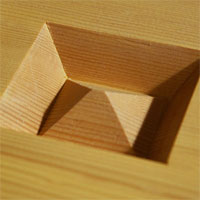
What is this mysterious pyramid?
Go boards can come in many sizes. Japanese standard size is approximately 18-1/4''L x 17-1/4''W (46cm x 43cm). Chinese standard size is slightly larger and more suitable when playing with larger stones, approximately 18-1/2" L x 17-3/8" W (47cm x 44cm). The standard gameplay grid has 19x19 lines, although there are also boards with 13x13 and 9x9 for faster games and teaching beginners.
Two of the most popular types of boards are Kaya (Torreya Nucifera) and Shin Kaya (made of various varieties of spruce). The most valued type of wood forgo playing is Old Kaya taken from Torreya trees that are several hundred years old. The wood is denser and gives off an especially fragrant scent, however logging of old growth Kaya trees are illegal in many countries because of their scarcity. Much of it now comes from Burma.
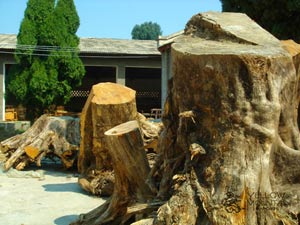
Kaya trees ready to be cut, stored and dried for go boards
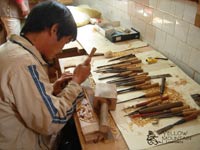
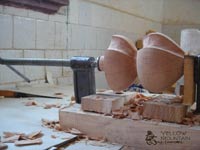
Bamboo boards are also becoming an excellent alternative wood for go boards. They have a natural beauty and, with a tensile strength stronger than steel, their durability is unmatched. Bamboo is also far more durable and heavy than any other wood boards. It will take a beating and still maintain its original beauty for years to come.
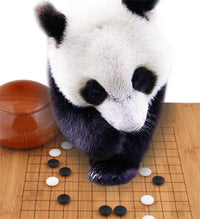
Go Stones
Go playing stones can be made from many types of material and come in varying sizes. The most common stone shape is double convex. In China, however, players prefer to play with single-convex stones because of the louder 'snap' the flat side makes when played on the board. They are also handy for flipping over when reviewing games and playing out variations. A standard set of Go stones has 181 black stones and 180 white. Black has an extra stone because it plays the first move. The total of 361 stones is enough to cover every intersection on the board. Of course, you can still play a complete game with fewer stones so don't worry if you end up missing a few.
Yunzi
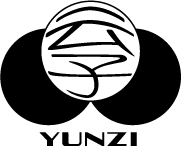
Yunzi stones are the national standard for professional tournaments in China. Yunzi has a long history dating back to the Tang Dynasty (618 A.D. – 907 A.D.). The stone has a property which absorbs moisture from one's fingertips without picking up dirt, and a resonant quality that gives it a pleasing sound as it lands on the board. Yunzi has a nice heft to it and is heavier than shell and slate stones of equal size. The white stones have an opaque milky eggshell luster. The traditional type of Yunzi, known as 'Old Yunzi', has a stronger hint of yellow in its white. Black Yunzi has a similar luster but when held up to the light it produces a bluish green halo along the rim.


Really old Yunzi from the Ming Dynasty
The actual composition of Yunzi is a tightly guarded secret known only to a select few in Yunnan Province, China. According to legend, the secret for making Yunzi stones was first revealed during the Tang Dynasty, when Taoist master Lu Dongbin, one of the "Eight Immortals" of Chinese myth, was traveling through the village of Yongchang in Baoshan County. He came upon a poor peasant who had devoted his life to taking care of his aged mother. Lu Dongbin taught the young man to make Yunzi stones out of agate and amber, materials which were plentiful in Yongchang. The young man soon became rich and "Yongzi" stones, as they were then called, became famous all over China.
After flourishing for hundreds of years and being the favorite of emperors, scholars, and monks, Yunzi stones production in Yongchang came to a halt when China was plagued by the civil war in the early 20th Century.
The secret to making Yunzi stones might have been lost forever if it weren't for Zhou Enlai, who took a trip to Baoshan County in the 1960's and charged the Yunnan Sports Commission with figuring out the secret formula for Yunzi stones. Old stones were available, as were old quarries for raw materials. But it wasn't until many years and hundreds of scientific experiments before a stone was produced that China's top Go players agreed was equal or superior to the old "Yongzi" stones.
Yunzi stones can only, by Chinese law, be produced by the state-run Yunzi company. The formula is still secret, although it's likely that the main ingredients are ground Yunnan mountain stones and agate.
How to Care for your Yunzi Stones
The black stones arrive with a little white powder on them. This is normal with new stones. Take the following steps to bring out the full luster:
- Rinse the stones clean under water and lay them out on a towel to dry.
- Place the stones in a plastic bag with a few drops of colorless oil and mix them around until the stones are all coated. Sewing machine oil is suitable, avoid cooking oils.
- Wipe the stones clean of excessive oil. Remember, the stones absorb moisture and oil from your fingers so the more you play, the nicer they will look!
Shell & Slate
Produced in Hyuga City, Japan, shell & slate are some of the most coveted types of stones out there in the Go world. While the game of go was introduced to Japan during the Taihō era (701 A.D. – 703 A.D., it wasn't until the 17th century that the Japanese began to make stones out of clam shells. Initially made in Hitachi and Kuwana, it was during the middle of the Meiji era (1868 – 1912) that the Japanese discovered using Hyuga clam shells for stones. The clams from Okuragahama beach in Hyuga had much thicker shells and finer grains, thus cementing the area's reputation as the home for shell and slate stones.

Do Not Eat
Hyuga city is now the only place in Japan where shell & slate stones are made. However, clam shells in Hyuga are nearly extinct, and while stones produced in Hyuga are still crafted with perfected traditional techniques, almost all of the shells are imported and harvested from off the coast of Baja California, Mexico. One can still find stones made from Hyuga shells but will have to expect to pay a premium of several times the price of normal shell & slate.

Okuragahama Beach
The stones come in different grades rated based on their coloration and line patterns. From lowest to highest the stones are rated as Standard (Jitsuyo), Moon (Tsuki) and Snow (Yuki). Snow grade shell stones are the whitest with the fine straight lines running across the top of the stone. Tuski stone lines are broader and curve across. Jitsuyo stones have more irregular and coarser lines with slight discoloration.
How to care for your shell & slate stones
You can clean your shell stones by simply wiping them off with a 100% cotton cloth. If the stones need more serious cleaning, mix them with a fresh egg and wash the stones in the mixture. Clean and rinse them in tepid water for a few minutes and let them dry overnight. Soap is also safe to use for cleaning. Do not use oil on shell stones!
Glass
The most common material used for stones. Glass stones are inexpensive yet have a very nice heft and feel to them. They also create a nice snapping sound when played on the board.
Ceramic
Another common and inexpensive material used for stones. Ceramic stones have a matte finish that has a more natural aesthetic appeal in contrast to the more glossy glass stones. These stones are very durable and don't chip easily.
Now for sizes. Here are some charts for making heads or tails out of Go stone sizing standards.
Double Convex Sizes
| Size | 25 | 28 | 30 | 31 | 32 | 33 | 34 | 35 | 36 | 37 | 38 | 39 | 40 | 41 | 42 | 43 | 44 | 45 |
| mm | 7.0 | 7.5 | 8.0 | 8.4 | 8.8 | 9.2 | 9.5 | 9.8 | 10.1 | 10.4 | 10.7 | 11 | 11.3 | 11.6 | 11.9 | 12.2 | 12.5 | 12.8 |
Single Convex Sizes
Chinese weiqi academy standard size is 21.5mm, 8.8, Old Yunzi. If you're looking for single convex, make sure you have the right size to fit your board!
| Size | 3 (Medium) | 4 (Medium) | 5 (Large) | 6 (Extra Large) |
| Diameter | 21.5-22mm | 22-22.5mm | 22.5-23.5mm | 23.5-24mm |
| Standard | Japanese | Chinese |
Bowls
Go bowls are traditionally made out of wood. However, you can also find bowls made from stone, straw, plastic and other materials as well. Bowl lids, in addition to keeping your stones secure inside, are also used to place your opponent's captured stones in during gameplay. Wood bowls generally come in two different shapes, Kitani and Go Seigen. These names are coined by popular Go lecturer, Janice Kim, 3 dan. The Go Seigen bowl refers to the shape of traditional Chinese style bowls and the Kitani refers to the shape of Japanese style bowls.


Left: Go Seigen bowl; Right: Kitani bowl
Conclusion
The most important thing about playing Go is having fun. Remember to blink your eyes once in a while when playing and make a lot of friends!



